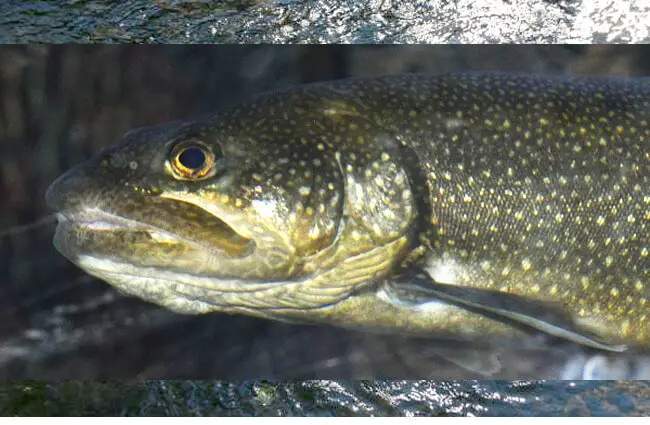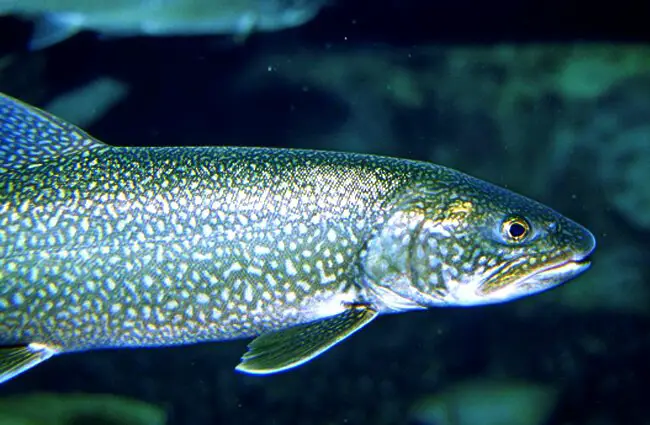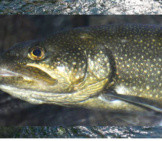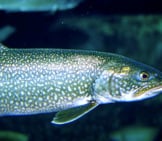The Lake Trout is a species in the Salmonidae family. Some of its relatives include the salmon, char, grayling, whitefish, and more. Not to be confused with the brown trout, which some people refer to as the “Lake Trout,” this species hails from a different taxonomic genus. Read on to learn about the Lake Trout.
Description of the Lake Trout
This species has dark colored scales, with a light-yellow abdomen, and light-colored speckles across its flanks. Its fins have a dark orange coloration and a thin white edge. As males begin spawning, they develop a dark colored stripe on the sides of their bodies.
On average, this fish weighs about six pounds, and measures about three feet long. However, some individuals reach much larger sizes.
Interesting Facts About the Lake Trout
This fish has a number of interesting traits and adaptations. Learn more about what makes this species unique, below.
- A Trout That’s a Char – This species is a member of the Salmonidae group known as the chars. People refer to many other species in this group as “trout” as well.
- Slow to Grow – Unlike some other members of this family, which perish after just a few years, this species has quite a long lifespan. In fact, most individuals do not reach sexual maturity until they are over a decade old!
- Slow to Repopulate – Unfortunately, this also means that it takes a long time for new generations of fish to reach breeding age. Because of this, the species is quite sensitive to overfishing.
- Splake – This species sometimes breeds with another close relative, the brook trout. The hybrid offspring of the two species, known as “splake,” have unique patterns and coloration. However, most hybrid offspring cannot reproduce, making them sterile.
Habitat of the Lake Trout
These fish live in cold, freshwater habitats. Unlike some other members of the Salmonidae family, they do not have anadromous tendencies, and live their entire lives in freshwater habitats. Their primary habitats include deep lakes and ponds. They also range into deep water rivers as well.
Distribution of the Lake Trout
Naturally, this species lives throughout northern North America. The majority of its populations live in Canada and Alaska, though some also naturally extend into the contiguous United States. However, humans have introduced this fish to other regions of the United States, as well as South America, New Zealand, and Sweden.
Diet of the Lake Trout
Dietary preferences vary based on the age of this fish. Younger fish feed primarily on smaller invertebrates, while adults hunt primarily for larger prey, like fish. The juveniles hunt for plankton, insects, insect larvae, worms, and more. Adults eat sculpin, alewives, smelt, minnows, and other small fish.
Lake Trout and Human Interaction
Humans interact with this species quite frequently, as anglers target this fish for sport. In fact, people introduced this species outside of its native range for that reason. In their native range, overfishing and pollution impact this species to varying degrees.
Though the IUCN has not assessed this fish, invasive species, pollution, overfishing, climate change, and other factors all impact regional populations.
Domestication
Humans have not domesticated this fish in any way.
Does the Lake Trout Make a Good Pet
No, this fish does not make a good pet. Because it reaches such large sizes, you must house it in an incredibly large tank. This makes it quite impractical to keep this species in a home aquarium.
Lake Trout Care
Some aquariums house this species, and some areas raise these fish in stocked ponds. They need lots of space for growth, and it takes quite a long time for them to reach sexual maturity. In human care, they receive a variety of fish, shrimp, and invertebrates as food.
Behavior of the Lake Trout
Adults of this species live solitary lives outside of breeding. They spend their time in deep habitats in the open water. In some regions, particularly warmer habitats, the fish must migrate during the summer to remain in cool, oxygen-rich waters. As breeding season arrives, the fish move into favored spawning areas.
Reproduction of the Lake Trout
Females choose a spawning site with a gravel bottom, and carefully clean the area of silt and debris. During spawning, the females release their eggs, and the males fertilize them externally.
The eggs take between four and six months to hatch. The young fish, known as fry, continue to hide in the gravel for some time before moving into deeper water to hunt for prey.

![Closeup of a Lake Trout under water Closeup of a Lake Trout under water Photo by: Engbretson Eric, U.S. Fish and Wildlife Service [Public domain]](https://animals.net/wp-content/uploads/2020/01/Lake-Trout-3-650x425.jpg)

![Fresh-caught Lake Trout Fresh-caught Lake TroutPhoto by: U.S. Fish and Wildlife Service [Public domain]](https://animals.net/wp-content/uploads/2020/01/Lake-Trout-4-650x425.jpg)
![A U.S. Fish and Wildlife Service fish hatchery receiving a million lake trout eggs. fish hatchery receiving a million lake trout eggs Photo by: U.S. Fish and Wildlife Service Northeast Region [Public domain]](https://animals.net/wp-content/uploads/2020/01/Lake-Trout-2-650x425.jpg)

![Closeup of a Lake Trout under water Closeup Of A Lake Trout Under Water Photo By: Engbretson Eric, U.s. Fish And Wildlife Service [Public Domain]](https://animals.net/wp-content/uploads/2020/01/Lake-Trout-3-162x141.jpg)

![Fresh-caught Lake Trout Fresh-Caught Lake Troutphoto By: U.s. Fish And Wildlife Service [Public Domain]](https://animals.net/wp-content/uploads/2020/01/Lake-Trout-4-162x141.jpg)
![A U.S. Fish and Wildlife Service fish hatchery receiving a million lake trout eggs. Fish Hatchery Receiving A Million Lake Trout Eggs Photo By: U.s. Fish And Wildlife Service Northeast Region [Public Domain]](https://animals.net/wp-content/uploads/2020/01/Lake-Trout-2-162x141.jpg)

![Red Angus Closeup of a beautiful Red Angus cowPhoto by: U.S. Department of Agriculture [pubic domain]https://creativecommons.org/licenses/by/2.0/](https://animals.net/wp-content/uploads/2020/03/Red-Angus-4-238x178.jpg)












![Red Angus Closeup of a beautiful Red Angus cowPhoto by: U.S. Department of Agriculture [pubic domain]https://creativecommons.org/licenses/by/2.0/](https://animals.net/wp-content/uploads/2020/03/Red-Angus-4-100x75.jpg)

